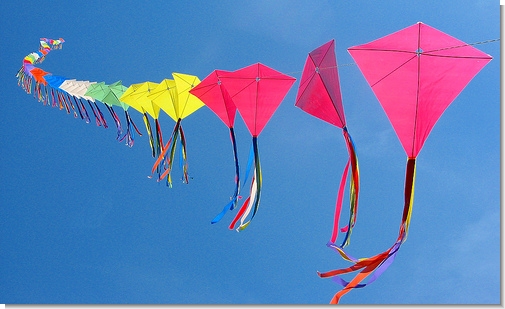We have discussed the symbolic use of kites in The Kite Runner and although to many of you they reflected Amir’s use of cliche they are worth discussing. Kites are popular today but they have ancient origins. It is believed that they date back at least three thousand years and originally came from China. Kites are particularly popular in Afghanistan as they symbolise national pride, history, independence, personal pride and religion.
Then I glanced up and saw a pair of kites, red with long blue tails, soaring up in the sky. They danced high above the trees on the west end of the park, over the windmills.
This description from the novel appears on page one. The kites represent the relationship between Amir and Hassan, they float close to one another occassionally bumping each other accidently or manipulated on purpose. As the kite flyer and the kite runner they are a perfect team as each is an expert in their own right.
Every winter, districts in Kabul held a kite-fighting tournament. If you were a boy living in Kabul, the day of the tournament was undeniably the highlight of the cold season … In Kabul, fighting kites was a little like going to war.
In Amir’s case this war takes a number of forms in the novel. There is the actual kite-fighting battle, his internal conflict over not protecting Hassan, the battle to win Baba’s attention and to earn his praise and finally the battle over whether to get involved in rescuing Sohrab. Another interesting thing about kites are that they are the only thing that Amir and Baba have in common. Their hopes, dreams and personalities are very different but kites are “the one paper thin slice of intersection between spheres of their existence.” Baba and Amir do eventually come to understand one another but it takes a long time to get there.
The end of the novel was hard for many of you to believe in because of the use of cliche and this was even more evident in your reactions to the film but remember that in Afghanistan kite-flying and fighting only have one rule and that is winning. This not only makes the fight scene between Assef and Amir more believable but it also reminds us why Amir is so desperate to win. Remember, to bring home the last fallen kite is a great honour. Amir betrayed Hassan to get it. Now Sohrab is that last fallen kite and Amir needs to not only win against Assef, he must also bring Sohrab home. It costs Amir and Sohrab a great deal but the final kite-flying scene suggests that Amir by taking on Hassan’s role for Sohrab has finally redeemed himself and has found goodness and redemption.

